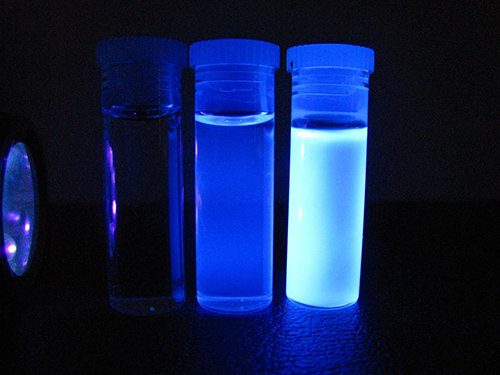Fluorescent Light Detector Seen to Easily Diagnose CF Through Sweat Chloride Levels

 Scientists at Pennsylvania State University have developed a relatively inexpensive, easy-to-use system for diagnosing cystic fibrosis (CF), a technique that uses florescent light to measure levels of chloride in perspiration, which are known to be elevated in CF patients.
Scientists at Pennsylvania State University have developed a relatively inexpensive, easy-to-use system for diagnosing cystic fibrosis (CF), a technique that uses florescent light to measure levels of chloride in perspiration, which are known to be elevated in CF patients.
The research was supported by the National Institute of Biomedical Imaging and Bioengineering (NIBIB), an arm of the National Institutes of Health (NIH).
About 70 percent of CF diagnoses are now made by measuring sweat chloride levels based on mercuric nitrate manual titration, a time-consuming and labor-intensive process, and one prone to technical error. Costly genetic testing is an alternative, but rarely used.
According to the researchers, an assessment of 84 hospitals concluded that improper training and inexperience are the greatest factors contributing to CF misdiagnosis, with false negative rates as high as 12 percent.
The low-cost and simplicity of the new system could also make accurate diagnoses of CF more accessible in lesser developed regions of the world, where conventional testing can be prohibitively expensive or is simply unavailable.
A genetic disorder estimated to affect some 30,000 Americans, CF is caused by a defect in the gene that regulates the flow of chloride into and out of cells, resulting in damage to the lungs and pancreas. Early detection is important so that measures can be taken to reduce fluid buildup in the lungs and to prevent malnutrition, and such timely interventions can help CF patients live longer and fuller lives.
The diagnostic system is described in an article in the journal Chemical Science, titled “Citrate-based fluorescent materials for low-cost chloride sensing in the diagnosis of cystic fibrosis.“ The team explains that while chloride is an essential electrolyte that maintains homeostasis within the body, abnormal chloride levels can indicate the presence of diseases like CF. They observed that current methods for chloride detection fail to meet the clinical needs of both high performance and low material and labor costs, hindering their use.
The method developed at Penn State is described in scientific terms as being a new class of fluorescence chloride sensors derived from a facile citrate-based synthesis platform that utilizes dynamic quenching mechanisms.
Essentially, the researchers developed a citrate-based dye that emits fluorescent light. But in the presence of chloride, the amount of light diminishes. They then created an automated system to detect the light and its changes — more chloride, lower fluorescence — and found that it compared favorably to current chloride-detection methods without the risk for human error. The also found that it can detect a wide range of chloride levels.
 “This is an important step towards faster, more reliable diagnosis,” said Seila Selimovic, PhD, program director of the NIBIB program in Biological Sensors, in a NIBIB press release. “The new sensing technology is cheap and easy to apply and, if used as part of a point-of-care device may allow more clinics to provide early cystic fibrosis tests. That is a great thing for the developed world, but is a game changer for the economically developing world.”
“This is an important step towards faster, more reliable diagnosis,” said Seila Selimovic, PhD, program director of the NIBIB program in Biological Sensors, in a NIBIB press release. “The new sensing technology is cheap and easy to apply and, if used as part of a point-of-care device may allow more clinics to provide early cystic fibrosis tests. That is a great thing for the developed world, but is a game changer for the economically developing world.”
Other current tests, such as ion-selective electrodes, can also produce poor results, the researchers said, because they are unable to distinguish between chloride and similar ions, such as bromide and iodide. Levels of these ions can also be elevated in perspiration as a result of certain medications or conditions. The Penn State system is also able to tell the difference between three types of ions: chloride, bromide, and iodide.
 “Our methods are very sensitive and also very selective,” said Jian Yang, PhD, a professor of biomedical engineering at Pennsylvania State University and the study’s senior author, “so we are able to use one dye to distinguish three different ions in one biological fluid. The system could also be used in other diseases that can be diagnosed by altered chloride levels, such as metabolic alkalosis, Addison’s disease, and amyotrophic lateral sclerosis (ALS), which present with abnormal amounts of chloride in urine, blood, and the fluid surrounding the brain, respectively.”
“Our methods are very sensitive and also very selective,” said Jian Yang, PhD, a professor of biomedical engineering at Pennsylvania State University and the study’s senior author, “so we are able to use one dye to distinguish three different ions in one biological fluid. The system could also be used in other diseases that can be diagnosed by altered chloride levels, such as metabolic alkalosis, Addison’s disease, and amyotrophic lateral sclerosis (ALS), which present with abnormal amounts of chloride in urine, blood, and the fluid surrounding the brain, respectively.”
Chloride-level testing can also help determine whether a treatment is working, but a sweat test now requires a hospital or clinical lab visit. To address this, the Penn State team created a prototype portable version of the device that plugs into a cellphone to detect light changes, and is simple enough to use so that patients might be able to monitor themselves at home.
“You just take the device, put the sweat in, and then you can use a cell phone to read the results,” said Yang. This portable tool would also be useful in small clinics and facilities in developing nations, which cannot afford the necessary personnel and equipment demanded by current testing methods to diagnose CF.
“We are stepping into the point-of-care device — this kind of low cost, easy to use, home-use device,” Yang concluded. “That can really make the detection of the sweat or even some other biological fluids like urine or serum much easier in the future because everyone can use it.”
Sources:
Pennsylvania State University
Chemical Science
National Institute of Biomedical Imaging and Bioengineering (NIBIB)







